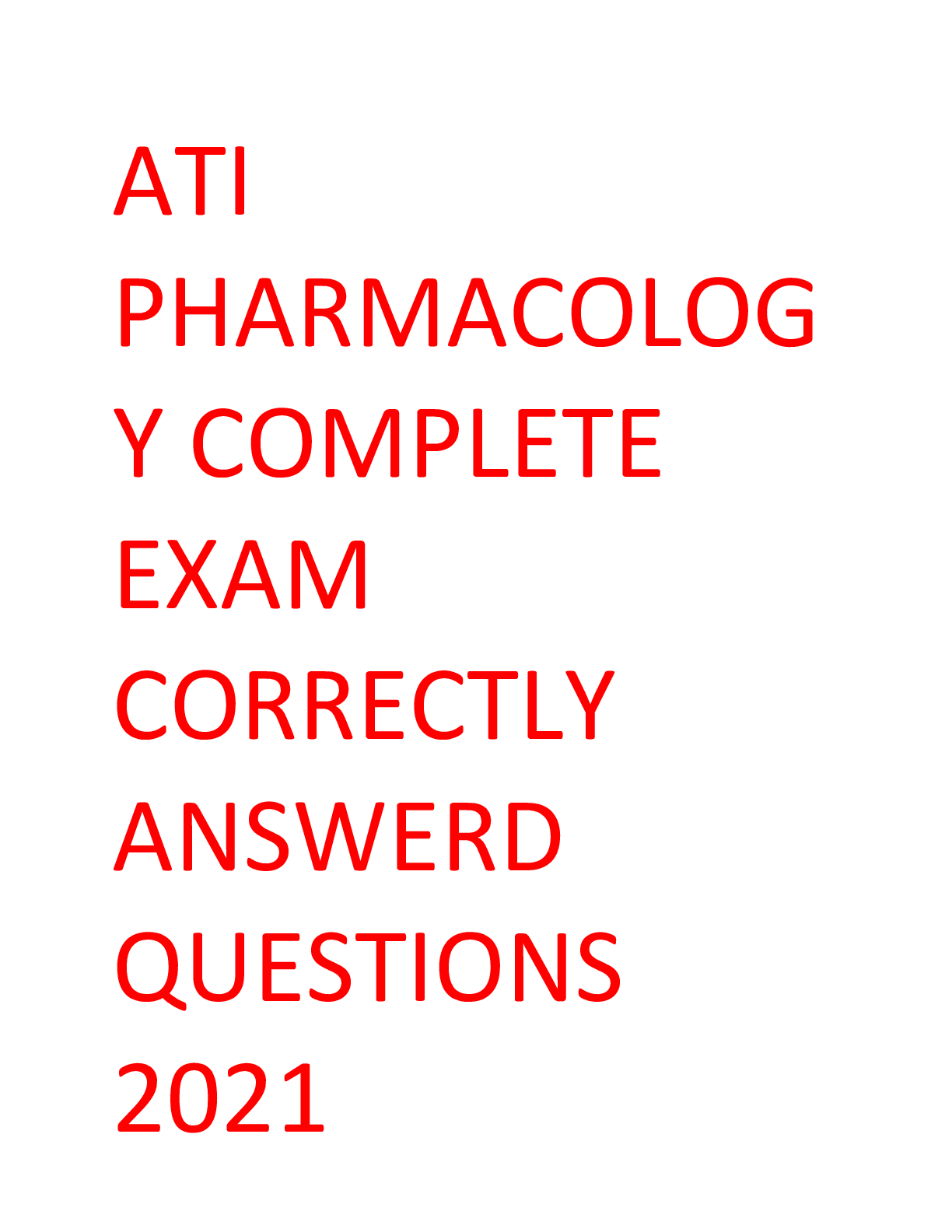NUR 2092 PRACTICE EXAM QUESTIONS (LATEST UPDATE)
Document Content and Description Below
NUR 2092 PRACTICE EXAM 1. During a Weber test, a patient with right ear hearing loss reports hearing sound longer in the right ear than the left ear. What results should the nurse expect to find fr... om this patient during a Rinne test? • Air conduction will be twice as long as bone conduction (2:1 ratio). • Air conduction will be 1.5 times as long as bone conduction (1.5:1 ratio). • Bone conduction will be longer than air conduction. • Bone conduction will be equal to air conduction. 2. A nurse reads in the history that a patient has a new onset of acute otitis media. Based on this information, how does the nurse expect this patient’s tympanic membrane to appear? • Dull • Shiny • Red • Blue to deep red 3. A nurse examines a patient’s auditory canal and tympanic membrane with an otoscope and observes which finding as normal? • Clear fluid lining the auditory canal • A firm tympanic membrane without fluctuation with puffs of air • A small hole within the cone of light • A shiny, translucent tympanic membrane 4. When using an ophthalmoscope to examine the internal eye, how does the nurse distinguish the retinal arteries from the retinal veins? • The arteries are narrower than veins. • The arteries are a darker red than veins. • The arteries have no light reflex and the veins have a narrow band of light in the center. • The arteries have prominent pulsations and veins have no pulsations. 5. During an eye examination of an Asian patient, a nurse notices an involuntary rhythmical, horizontal movement of the patient’s eyes. How does a nurse document this finding? • An expected racial variation • Nystagmus • Exophthalmus • Myopia 6. How does a nurse recognize normal accommodation? • The patient has peripheral vision of 90 degrees left and right. • The patient’s eyes move up and down, side to side, and obliquely. • The right pupil constricts when a light is shown in the left pupil. • The patient’s pupils dilate when looking toward a distant object. 7. When inspecting a patient’s eyes, the nurse assesses the presence of cranial nerve III (oculomotor nerve) by observing the eyelids open and close bilaterally. What other technique does a nurse use to test the function of this cranial nerve? • Pupillary constriction to light • Visual acuity • Peripheral vision • Presence of the red reflex 8. Which cranial nerve is assessed by using the Snellen visual acuity chart? • Optic cranial nerve (CN II) • Oculomotor cranial nerve (CN III) • Abducens cranial nerve (CN IV) • Trochlear cranial nerve (CN VI) 9. The nurse is taking a health history on a patient who reports frequent stabbing headaches occurring once a day lasting about an hour. Which statement by the patient is most indicative of cluster headaches? • “I usually have nausea and vomiting with my headaches.” • “My whole head is constantly throbbing.” • “It feels like my head is in a vice.” • “The pain is on the left side over my eye, forehead, and cheek.” 10. A patient is admitted with edema of the occipital lobe following a head injury. The nurse correlates which finding with damage to this area? • Ipsilateral ptosis • Impaired vision • Pupillary constriction • Increased intraocular pressure 11. Which question will give the nurse additional information about the nature of a patient’s dyspnea? • “How often do you see the physician?” • “How has this condition affected your day-to-day activities?” • “Do you have a cough that occurs with the dyspnea?” • “Does your heart rate increase when you are short of breath?” 12. A patient complains of shortness of breath and having to sleep on three pillows to breathe comfortably at night. During the nurse’s examination, what findings will suggest that the cause of this patient’s dyspnea is due to heart disease rather than respiratory disease? • Increased anteroposterior diameter • Clubbing of the fingers • Bilateral peripheral edema • Increased tactile fremitus 13. A nurse inspects a patient’s hands and notices clubbing of the fingers. The nurse correlates this finding with what condition? • Pulmonary infection • Trauma to the thorax • Chronic hypoxemia • Allergic reaction 14. A patient is admitted to the emergency department with a tracheal obstruction. What sound does the nurse expect to hear as this patient breathes? • Dull sounds on percussion • Soft, muffled rhonchi heard over the trachea • Bubbling or rasping sounds heard over the trachea • High-pitched sounds on inspiration and exhalation 15. Where does a nurse expect to hear bronchovesicular lung sounds in a healthy adult? • In the lower lobes • Over the trachea • In the apices of the lungs • Near the sternal border 16. A nurse is assessing for vocal (tactile) fremitus on a patient with pulmonary edema. Which is the appropriate technique to use? • Systematically percuss the posterior chest wall following the same pattern that is used for auscultation and listen for a change in tone from resonant to dull. • Place the pads of the fingers on the right and left thoraces and palpate the texture and consistency of the skin feeling for a crackly sensation under the fingers. • Place the palms of the hands on the right and left thoraces, ask the patient to say “99,” and feel for vibrations. • Place both thumbs on either side of the patient’s spinal processes, extend fingers laterally, ask the patient to take a deep breath, and feel for vibrations. 17. A nurse palpating the chest of a patient finds increased fremitus bilaterally. What is the significance of this finding? • An expected finding • Chronic obstructive pulmonary disease • Bilateral pneumonia • Bilateral pneumothorax 18. A nurse is assessing the respiratory system of a healthy adult. Which findings does this nurse expect to find? Select all that apply. • Thoracic expansion that is symmetric bilaterally • Respiratory rate of 24 breaths/min • Bronchophony revealing clear voice sounds • Breath sounds clear with vesicular breath sounds heard over most lung fields • Anteroposterior diameter of the chest about a 1:2 ratio of anteroposterior to lateral diameter • Symmetric thorax with ribs sloping downward at about 45 degrees relative to the spine 19. A nurse informs a patient that her blood pressure is 128/78. The patient asks what the number 128 means. What is the nurse’s appropriate response? The 128 represents the pressure in your blood vessels when: • “The ventricles relax and the aortic and pulmonic valves open.” • “The ventricles contract and the mitral and tricuspid valves close.” • “The ventricles contract and the mitral and tricuspid valves open.” • “The ventricles relax and the aortic and pulmonic valves close.” 20. The patient describes her chest pain as “squeezing, crushing, and 12 on a scale of 10.” This pain started more than an hour ago while she was resting, and she also feels nauseous. Based on these findings, the nurse should assess for which associated symptoms? • Tachycardia, tachypnea, and hypertension • Dyspnea, diaphoresis, and palpitations • Hyperventilation, fatigue, anorexia, and emotional strain • Fever, dyspnea, orthopnea, and friction rub 21. What cardiac area is the nurse assessing? o Apical o Tricuspid o Mitral o Erb’s point 22. When auscultating the heart of a patient with pericarditis, the nurse expects to hear which sound? • A systolic murmur • An S3 heart sound • A friction rub • An S4 heart sound 23. How does a nurse accurately palpate carotid pulses? • Two fingers of each hand are placed firmly over the right and left temples at the same time. • One finger is placed gently in the space between the biceps and triceps muscles. • Two fingers are placed at the thumb side of the forearm at the wrist. • One finger is placed along the right and then the left medial sternocleidomastoid muscle. 24. A nurse is having difficulty auscultating a patient’s heart sounds because the lung sounds are too loud. What does the nurse ask the patient to do to improve hearing the heart sounds? • Lie in a supine position. • Cough. • Hold his or her breath for a few seconds. • Sit up and lean forward. 25. Which valve does a nurse auscultate when the stethoscope is placed on the fourth intercostal space at the left of the sternal border? • Pulmonic • Tricuspid • Mitral • Aortic 26. Which position is this patient in? See image below Please write your answer here______________. 27. After two separate office visits, the nurse suspects that a patient is developing Stage 1 hypertension based on which consecutive blood pressure readings? • Visit 1, 118/78; Visit 2, 116/76 • Visit 1, 130/88; Visit 2, 134/88 • Visit 1, 144/92; Visit 2, 150/90 • Visit 1, 162/100; Visit 2, 166/104 28. What is the following a picture of? o Ascites o Pregnancy o Obesity o Congestive heart failure 29. A patient reports having abdominal distention and having vomited several times yesterday and today. What question is appropriate for the nurse to ask in response to this information? • “Has there been a change in your usual pattern of urination?” • “Did you have heartburn before the vomiting?” • “What did the vomitus look like?” • “Have you noticed a change in the color of your urine or stools?” 30. How does the nurse accurately assess bowel sounds? • Press the diaphragm of the stethoscope firmly against the abdomen in each quadrant. • Hold the diaphragm of the stethoscope lightly against the abdomen in each quadrant. • Press the bell of the stethoscope firmly against the abdomen in each quadrant. • Hold the bell of the stethoscope lightly against the abdomen in each quadrant. 31. What instructions does the nurse give a patient before palpating the abdomen? • Bend the knees. • Take a deep breath and hold it. • Take a deep breath and cough. • Place the hands over the head. 32. A nurse expects which finding when assessing the abdomen of a patient who has been unable to void for 12 hours? • Absent bowel sounds • Hyperactive bowel sounds • Tympanic tones over the lower abdomen • Dull tones over the suprapubic area 33. On palpation of the left upper quadrant of the abdomen of a female patient, the nurse notes tenderness. This finding may indicate a disorder in which organ? • Spleen • Gallbladder • Sigmoid colon • Left ovary 34. Which location does a nurse select when palpating a patient’s liver • (right lower quadrant) • (right upper quadrant) • (left upper quadrant) • (left lower quadrant) 35. The nurse recognizes which clinical finding as expected on palpation of the abdomen? • Inability to palpate the spleen • Left kidney rounded at 2 cm below the costal margin • Slight tenderness of the gallbladder on light palpation • Bounding pulsation of the aorta over the umbilicus 36. The nurse moves a wisp of cotton lightly across the anterior scalp, paranasal sinuses, and lower jaw to test the function of which cranial nerve? • CN IV (trochlear nerve) • CN V (trigeminal nerve) • CN VI (abducens nerve) • CN VII (facial nerve) 37. The nurse assesses the glossopharyngeal nerve (CN IX) by testing which reflex? • Corneal reflex • Gag reflex • Blink reflex • Cough reflex 38. What is the patient’s expected response when the nurse is assessing graphesthesia? • Lies supine and runs one heel along the opposite shin • Identifies a familiar object placed in the hands • Describes where a sensation of a vibrating tuning fork is felt • Identifies a letter or number drawn in the hand 39. What is the patient’s expected response when the nurse is assessing stereognosis? • Identifies an object placed in the hand • Distinguishes numbers or letters traced in the palm of the hand • Touches the index finger of the nondominant hand to the nose • Walks heel to toe in a straight line 40. What technique does the nurse use to test the patellar deep tendon reflex? • Using the end of the handle on the reflex hammer, the nurse strokes the lateral aspect of the sole of the patient’s foot from heel to ball. • Ask the patient to flex one knee to 90 degrees, while the nurse dorsiflexes the ankle and strikes the appropriate tendon on the foot with the flat end of the reflex hammer. • Ask the patient to flex one knee to 45 degrees, while the nurse plantar flexes the ankle and strikes the appropriate tendon of the ankle with the pointed end of the reflex hammer. • Ask the patient to flex one knee to 90 degrees, while the nurse strikes the appropriate tendon in the knee with the blunt end of the reflex hammer 41. Name which tendon is being evaluated for deep tendon reflex from the picture illustrated below. A. B. C. D. E. F. G. 42. As a nurse is inspecting the nails of a patient with chronic hypoxemia and notices enlargements of the ends of the fingers and angles of the nail base greater than a straight line (exceeding 180 degrees). How does the nurse document these findings? • An expected finding • Koilonychia (spoon nail) • Clubbing • Leukonychia 43. A patient is visiting an urgent care center after being hit in the back with a baseball. Upon examination, the nurse notes a flat, nonblanchable spot 2.25 cm wide that is reddish-purple in color. How does the nurse document this lesion? • As an angioma • As purpura • As petechiae • As ecchymosis 44. What findings does the nurse expect when assessing skin, hair, and nails of a healthy male adult? Select all that apply. • Transverse depression noticed across nails • Scalp is bald • Elevated, firm, circumscribed area less than 1 cm wide found on the fingers • Purpura and ecchymosis are noticed on arms and legs • Freckles are noted on face, back, arms, and legs • Skin turgor is elastic 45. Identify the following spinal defects from the image below. You ONLY have to answer A, B, C, and E. [Show More]
Last updated: 2 years ago
Preview 1 out of 14 pages
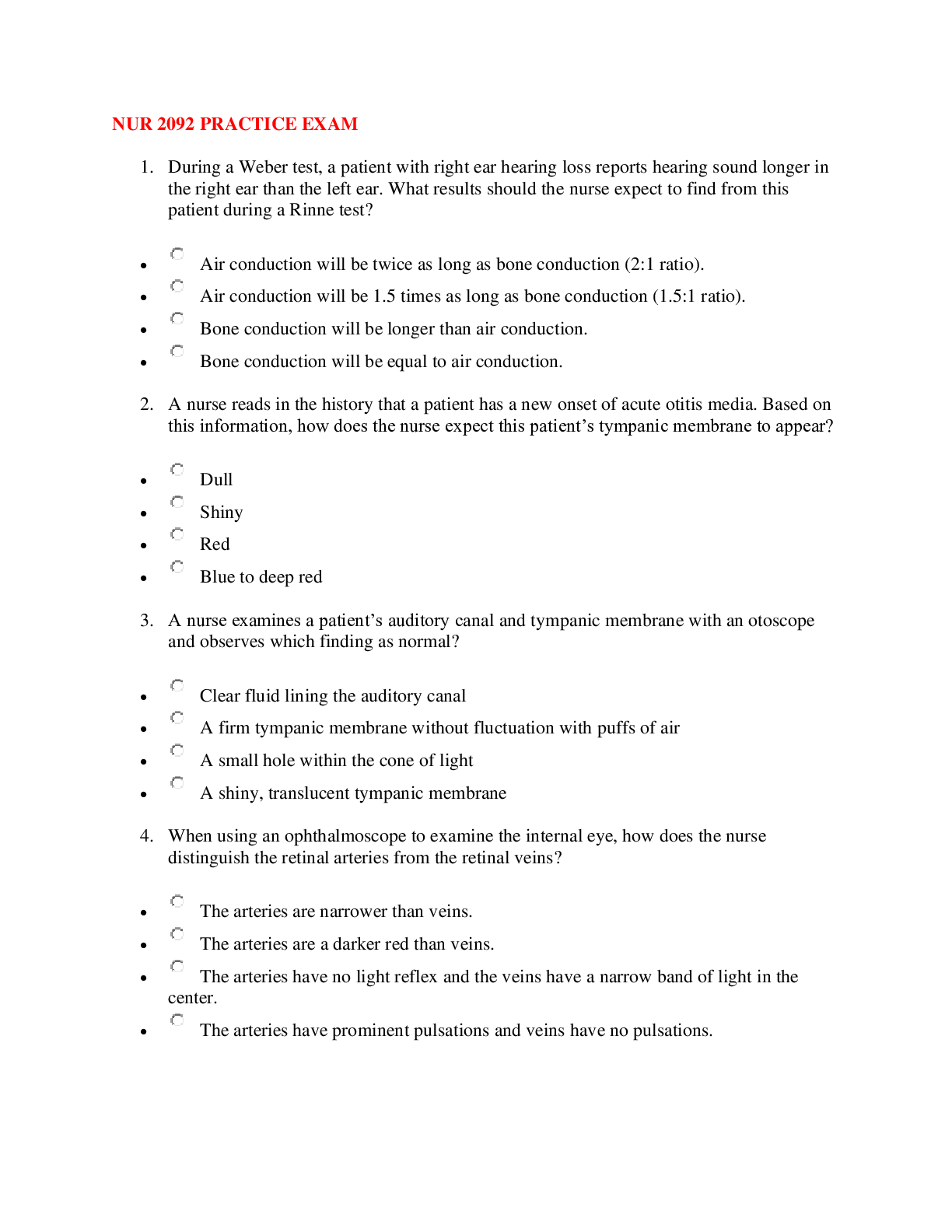
Buy this document to get the full access instantly
Instant Download Access after purchase
Buy NowInstant download
We Accept:

Reviews( 0 )
$13.00
Can't find what you want? Try our AI powered Search
Document information
Connected school, study & course
About the document
Uploaded On
Feb 18, 2021
Number of pages
14
Written in
Additional information
This document has been written for:
Uploaded
Feb 18, 2021
Downloads
0
Views
108

.png)




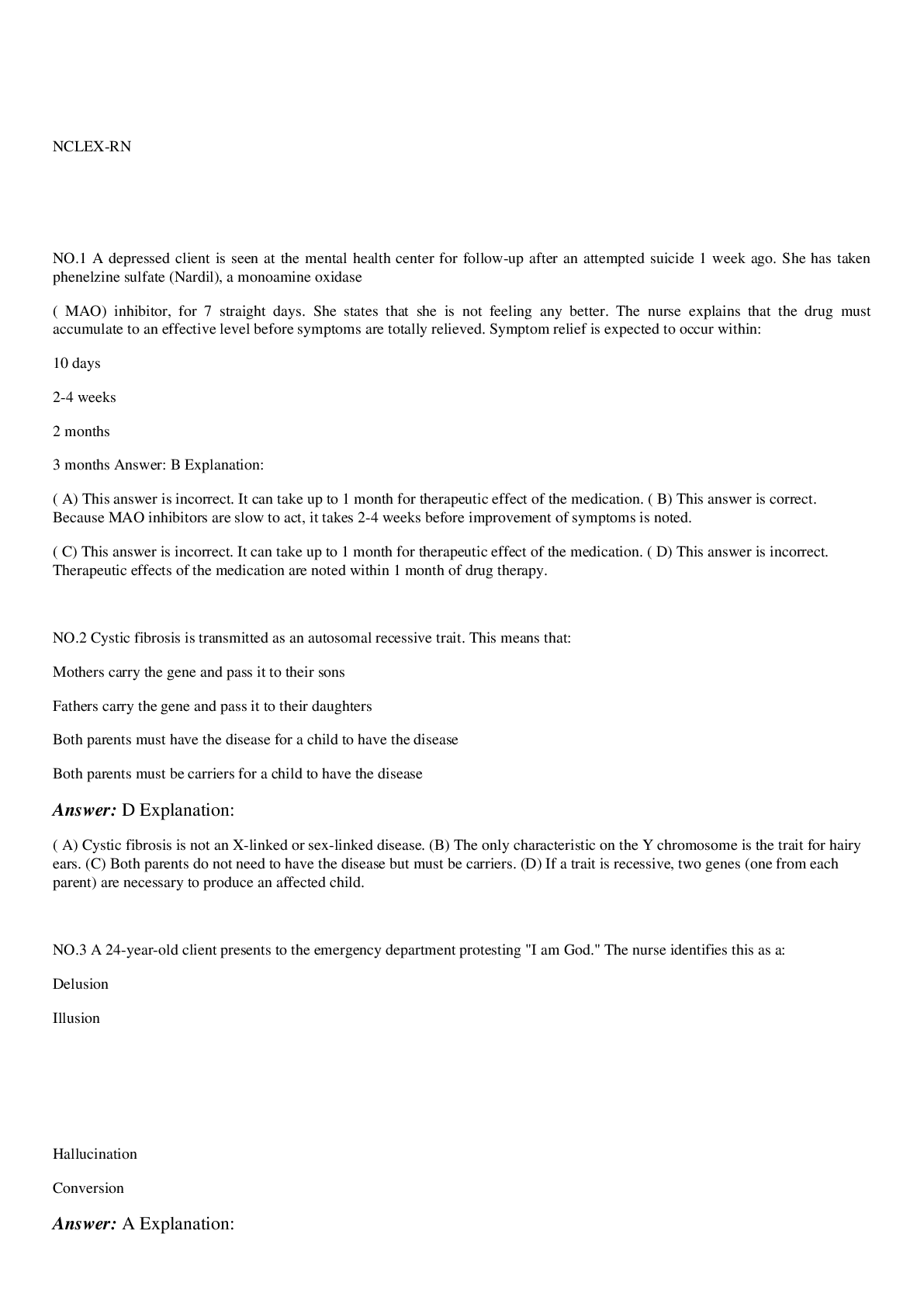
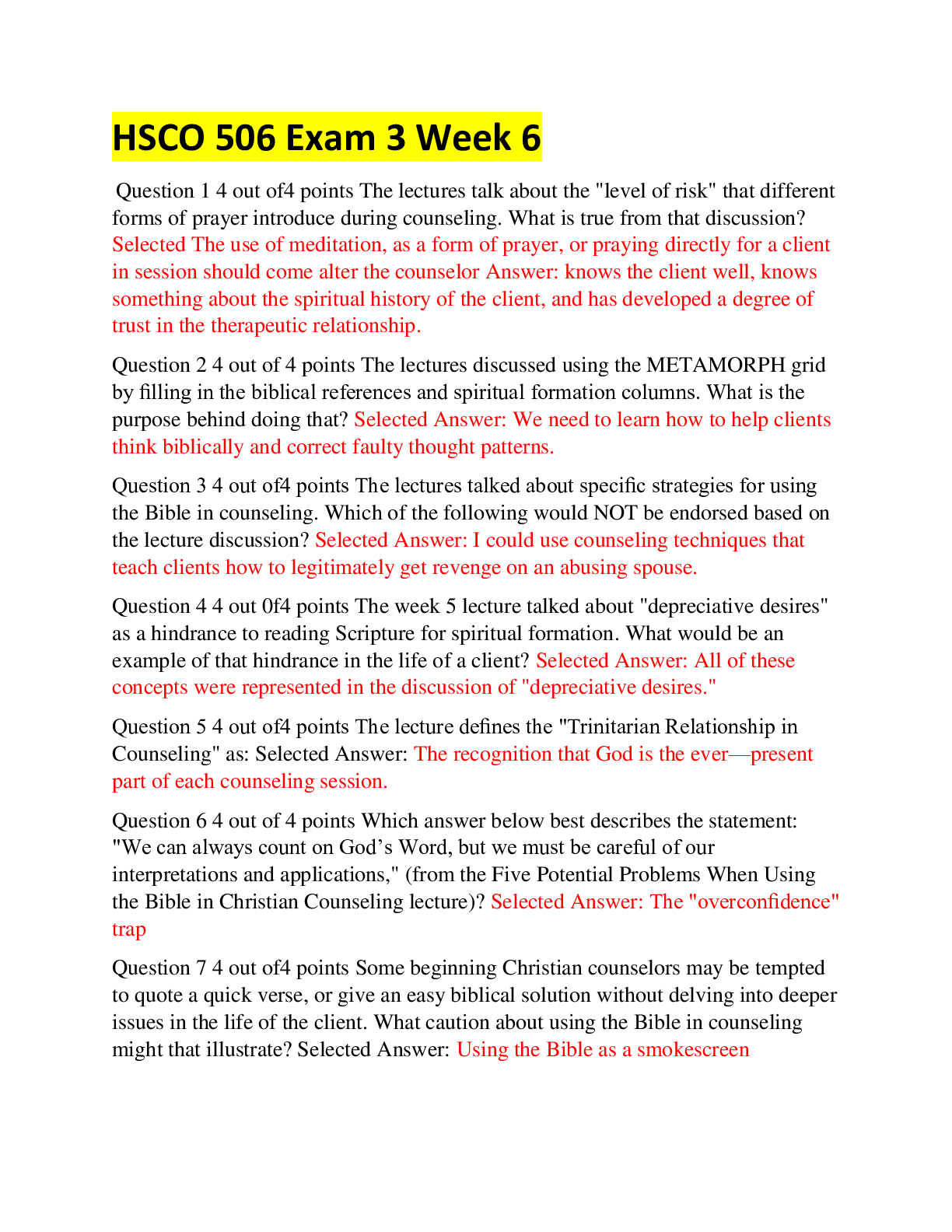

.png)





.png)


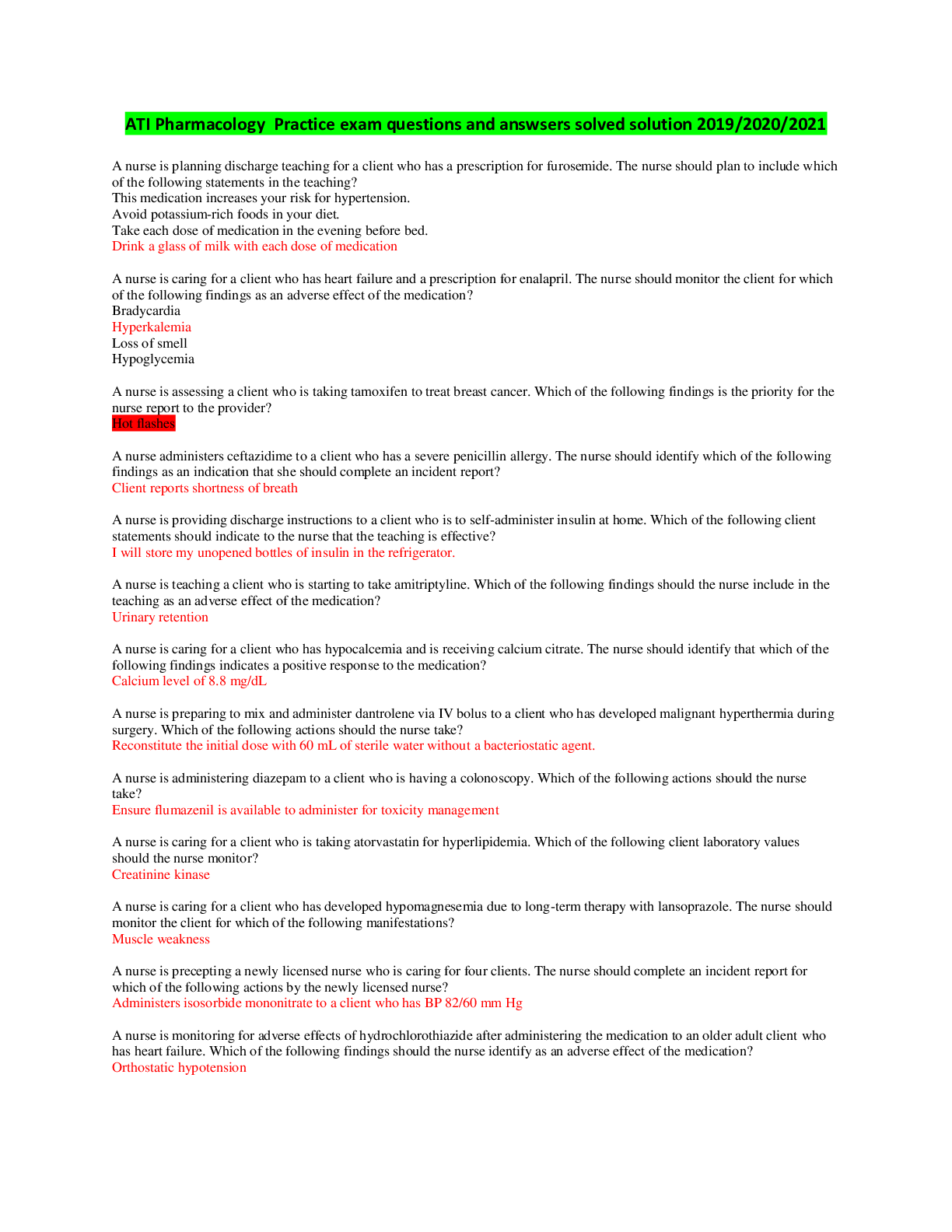

.png)
